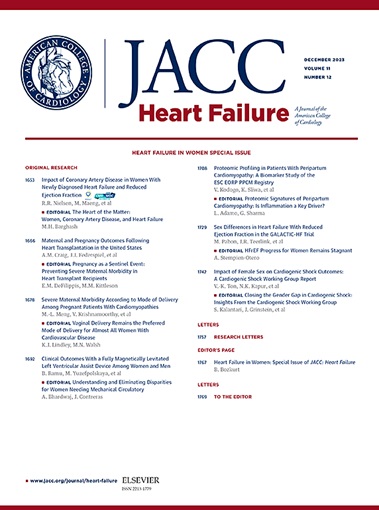射血分数表型对心力衰竭缺铁的定义
IF 11.8
1区 医学
Q1 CARDIAC & CARDIOVASCULAR SYSTEMS
引用次数: 0
摘要
背景:在心力衰竭(HF)中如何定义铁缺乏(ID)可能会影响ID患病率、相关预后和可实现的静脉补铁获益。目的:本研究评估了4种心力衰竭伴射血分数降低(HFrEF)、心力衰竭伴射血分数轻度降低(HFmrEF)和心力衰竭伴射血分数保留(HFpEF)的ID定义,并评估了患病率、相关健康相关生活质量(HR-QoL)、症状和病因特异性发病率和死亡率。方法纳入2017年至2023年在瑞典HF注册中心登记的患者。ID定义如下:1)在现行HF指南中;2)在IRONMAN(静脉铁治疗心力衰竭和缺铁患者)试验中;3)转铁蛋白饱和度(TSAT)≤20%;4)铁蛋白值为100 μg/L。结果20,673例患者(中位年龄74岁[第一季至第三季:65-80岁],32%为女性)中,49%符合指南ID标准(HFrEF, 48%; HFmrEF, 48%; HFpEF, 54%), 53%符合IRONMAN标准(HFrEF, 52%; HFmrEF, 52%; HFpEF, 59%), 36% TSAT和lt;20% (HFrEF, 36%; HFmrEF, 34%; HFpEF, 41%), 37%铁蛋白水平和lt;100 μg/L (HFrEF, 35%; HFmrEF, 37%; HFpEF, 42%)。所有定义均与症状加重独立相关,除铁蛋白100 μg/L外,其余定义均与HR-QoL加重相关。TSAT <;20%和IRONMAN ID标准与所有结局的较高风险独立相关,包括心血管或全因死亡和HF或全因/心血管/非心血管住院。指南定义的ID仅与HF住院或全因住院的结局独立相关,而铁蛋白100 μg/L与结局无关。TSAT <;20%和IRONMAN ID标准与HFpEF与HF住院的结果有更强的关联(P相互作用<; 0.05)。TSAT <;20%表现出最大的预后关联和歧视。结论与定义不同,ID非常普遍(在HFpEF中最高),且与较差的症状或HR-QoL独立相关。定义为TSAT <;20%的ID与包括死亡率和心衰或心血管/非心血管住院在内的结果有最强的相关性,可能代表了在试验中纳入高风险组的首选定义。本文章由计算机程序翻译,如有差异,请以英文原文为准。
Iron Deficiency Definitions in Heart Failure Across Ejection Fraction Phenotypes
Background
How iron deficiency (ID) is defined in heart failure (HF) may affect ID prevalence, associated prognosis, and achievable intravenous iron benefit.
Objectives
This study assessed 4 definitions of ID in heart failure with reduced ejection fraction (HFrEF), heart failure with mildly reduced ejection fraction (HFmrEF), and heart failure with preserved ejection fraction (HFpEF) and evaluated prevalence, associated health-related quality of life (HR-QoL), symptoms, and cause-specific morbidity and mortality.
Methods
Patients enrolled in the Swedish HF Registry from 2017 to 2023 were included. ID was defined as follows: 1) in current HF guidelines; 2) in the IRONMAN (Intravenous Iron Treatment in Patients With Heart Failure and Iron Deficiency) trial; 3) with transferrin saturation (TSAT) <20%; and 4) with a ferritin value <100 μg/L.
Results
Of 20,673 patients (median age 74 years [Q1-Q3: 65-80 years]; 32% female), 49% fulfilled guideline ID criteria (HFrEF, 48%; HFmrEF, 48%; HFpEF, 54%), 53% fulfilled IRONMAN criteria (HFrEF, 52%; HFmrEF, 52%; HFpEF, 59%), 36% had TSAT <20% (HFrEF, 36%; HFmrEF, 34%; HFpEF, 41%), and 37% has a ferritin level <100 μg/L (HFrEF, 35%; HFmrEF, 37%; HFpEF, 42%). All definitions were independently associated with worse symptoms, and all except ferritin <100 μg/L were associated with worse HR-QoL. TSAT <20% and IRONMAN ID criteria were independently associated with a higher risk of all outcomes, including cardiovascular or all-cause death and HF or all-cause/cardiovascular/noncardiovascular hospitalizations. Guidelines-defined ID was independently associated only with outcomes containing HF hospitalizations or total all-cause hospitalizations, and ferritin <100 μg/L was associated with no outcome. TSAT <20% and IRONMAN ID criteria had stronger associations in HFpEF for outcomes containing HF hospitalization (P interaction < 0.05). TSAT <20% showed the greatest prognostic associations and discrimination.
Conclusions
Irrespective of definition, ID was highly prevalent (highest in HFpEF) and independently associated with worse symptoms or HR-QoL. ID defined as TSAT <20% showed the strongest associations with outcomes, including mortality and HF or cardiovascular/noncardiovascular hospitalizations, likely representing the preferred definition with which to enroll a higher-risk group in trials.
求助全文
通过发布文献求助,成功后即可免费获取论文全文。
去求助
来源期刊

JACC. Heart failure
CARDIAC & CARDIOVASCULAR SYSTEMS-
CiteScore
21.20
自引率
2.30%
发文量
164
期刊介绍:
JACC: Heart Failure publishes crucial findings on the pathophysiology, diagnosis, treatment, and care of heart failure patients. The goal is to enhance understanding through timely scientific communication on disease, clinical trials, outcomes, and therapeutic advances. The Journal fosters interdisciplinary connections with neuroscience, pulmonary medicine, nephrology, electrophysiology, and surgery related to heart failure. It also covers articles on pharmacogenetics, biomarkers, and metabolomics.
 求助内容:
求助内容: 应助结果提醒方式:
应助结果提醒方式:


